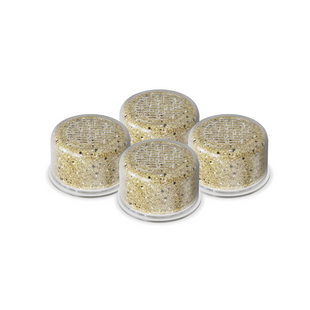Ionizer or ionic air purifier is a buzzword you may have encountered when researching air purifiers. What does an ionizer do? Do ionizers work? How do ionizers work, at that? We answer all of your burning questions in this blog post including a brief review of the negative effects of ionizers and healthy alternatives to the ionic air purifier should you choose to invest in an alternative air purifying source.
What is an Ionizer Air Purifier?
An ionic air purifier is also commonly referred to as an ionizer and an ionizing air purifier.
The ionizer is an air purifying device that uses charged molecules called ions to stick to airborne particles creating a negative charge. Negatively charged molecules are attracted to other negatively charged molecules creating a clump of molecules that settle on nearby electrically charged surfaces like your carpet, upholstery, linens, countertops, curtains, and more. The discarded particles can be vacuumed up or washed from fabrics in the washing machine.

Ionic air purifiers are ineffective with gaseous pollutants and aim at removing particulate pollutants from a space, though not entirely. Since the molecule clumps fall on nearby surfaces, if not cleaned regularly, the debris can reenter the air in the room if you turn on a fan, open a window for a crossbreeze, or turn on the air conditioner.
The Negative Effects of Ionizer Air Purifiers
The ionic air purifier hit markets in the early 2000’s with a specific model, the Ionic Breeze by Sharper Image, collecting a lion’s share of the market. In 2003, Consumer Reports conducted a test to determine whether the ionic air purifier was effective in removing airborne toxins; the results are substantially low when measured against the HEPA filter, which we will review as an ionizer alternative below.
In 2005, Consumer Reports released additional product testing results, which revealed that the Ionic Breeze ionic air purifier released trace amounts of ozone into the environment. Testing showed that the Ionic Breeze released 2.2 milligrams of ozone per hour, which is similar to the levels of ozone released by a constantly running photocopier.
While ozone is used frequently to sterilize and decontaminate a space, at certain levels, ozone is considered dangerous and may result in an unhealthy living condition. Even at low concentrations, ozone is particularly irritating to allergy and asthma sufferers and may cause throat irritation, persistent cough, shortness of breath, and chest pain among healthy individuals according to the EPA. The EPA furthermore recommends against intentionally generating ozone in your home environment.
Healthy Alternatives to the Ionizer Air Purifier
Now that we have answered the questions: “What does an ionizer do?“ and “How do ionizers work?” and addressed the negative effects of an ionizer, we feel confident that you are equipped with the knowledge you need to determine whether an ionic air purifier is right for you.
If you are interested in healthy alternatives to an ionizer device, there are plenty from which to choose: from HEPA filters to himalayan sea salt lamps, you are destined to find the perfect alternative solution for your air purification needs.
HEPA Filters
A great alternative to an ionic air purifier is the high efficiency particulate air filter or HEPA filter. According to the EPA, a HEPA filter can remove 99.7% of pollutants including dust, pollen, mold, bacteria, and airborne particles.
You can use a HEPA filter for your HVAC system or in your portable air purifier for increased antimicrobial activity. If you or someone in your home suffers from asthma or allergies, a HEPA filter is a highly effective and trusted defense against airborne pathogens.
Activated Charcoal
A natural, alternative solution to the ionic air purifier is the carbon air filter or the activated charcoal air filter. Carbon filters are effective against indoor gaseous pollutants including (but not limited to): fossil fuel, cigarette smoke, construction materials, fumes from cleaning products, and more. Carbon filters are not very effective with removing particulate matter (PM), however, and do require frequent changing so it is important to keep these factors in mind when deciding which alternative to the ionic air purifier that works best for you and your home.
Essential Oil Diffusion
Essential oils are gaining in popularity as new studies reveal the immense benefit of essential oil diffusion and topical application. A study conducted by Atmospheric Environment revealed that lavender, tea tree, and eucalyptus essential oils reduced antimicrobial activity in an indoor environment from essential oil diffusion. Another study in the Molecular Medicine Reports found essential oils to improve bacterial colony growth on surfaces and in the air, and yet another study found frankincense essential oil to possess clear antimicrobial properties through vaporization.

Essential oils with air purifying properties include: tea tree, rosemary, frankincense, oregano, thyme, lemon, lime, lavender, and more. You can now diffuse your favorite blend of air purifying essential oils with Canopy Diffuser, a no water, no mist diffuser that will radically change the way you experience the power of aromatherapy. Our no mist technology prevents harmful bacteria and particles from entering the environment irritating your lungs and skin while the no mist feature prevents mold growth from messy water spills. With Canopy Diffuser, you can diffuse two ways: our Aroma Puck allows for short term diffusion while the Diffusion Well has a place for your favorite essential oil for long-term, unadulterated aromatherapy.
Houseplants
Do ionizers work? Well, not as well as your cherished houseplant! Those houseplants you tenderly care for, water regularly, and whisper sweet nothings to on the daily are a great alternative to ionic air purifiers.
Houseplants help to naturally filter the air. In fact, NASA conducted a study in which they analyzed various plants' air filtering potential and found that the plant roots and the associated microorganisms in the soil adapted to completely destroy viruses, bacteria, and organic chemicals and repurpose these pollutants into new plant tissue. Wild!
You can place your houseplants in high traffic areas of your home or place a green friend in every room of your house assuming the plant has adequate sunlight and humidity levels to thrive.
Himalayan Sea Salt Lamp

Last, but certainly not the least effective alternative to the ionic air purifier is the himalayan sea salt lamp. You may have spotted these orange-hued salt lamps on Pinterest or on social media, with no clue as to how they work or what exactly they do.
Sea salt lamps work by pulling polluted moisture from the environment, neutralizing it, and subsequently reducing airborne pollutants, pathogens, and common household allergens. The result is a clean, toxin-free space with a soothing ambiance. You can leave your himalayan sea salt lamp on throughout the night as an added perk! The orange hue emitted from these lamps does not interfere with the body’s circadian rhythm allowing you to sleep peacefully and comfortably.























